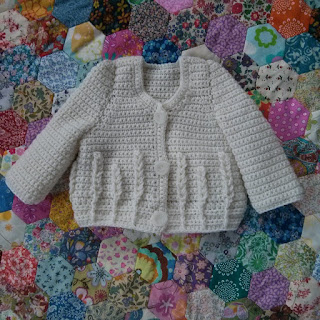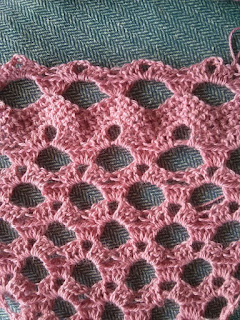With her baby alpaca fur and her Liberty Tana Lawn cotton ears, Agnes is the softest, most luxurious bunny ever! She is crocheted using amigurumi techniques and all her cute little details are hand stitched after she has been sewn together.
This pattern is rated BEGINNER level.
You will need ...
1x 100g skein of Juniper Moon Farm extrafine baby alpaca in Bullrush (200m per 100g, DK weight)
10x10cm piece of Liberty Tana Lawn cotton in Felicite (for ears)
3mm crochet hook
scrap of contrast yarn or stitch marker
2 small, vintage shell buttons (for eyes)
green sewing thread (for eyes)
terracotta coloured embroidery thread (for sewing nose and mouth)
small piece of mint coloured wool felt (for mouth)
needle (for thread)
tapestry needle (for sewing body parts together)
toy stuffing
Finished Size and Tension
The stuffed bunny is 34cm from tip of ears to toes. Tension should be tight for making amigurumi, you may need to switch to a 2.5mm hook. The stuffed head should be about 6.5cm diameter (top tip; you could use the head as a tension guide).
Abbreviations (UK terms)
ch chain
ss slip stitch
dc double crochet
dc2tog double crochet 2 stitches together (see notes)
beg begin
rep repeat
dec decrease
inc increase
htr half treble
Tr treble
trCl treble cluster (see notes)
yo yarn over
RS right side
Notes
I have given instructions for both the magic loop method and the chain 2 method of starting - choose whichever you are most comfortable with. Here is a useful link to the magic loop method http://www.simplycrochetmag.co.uk/2014/10/20/make-magic-loop/
For the head pattern I have staggered the increases to avoid the hexagonal look which standard amigurumi methods create. I have not done so for the body because it is less noticeable.
Invisible decreases are another of the crochet techniques I like to use in my patterns because it creates such a smooth and flawless look. Where I have indicated dc2tog; insert hook through front loop only (flo) of 1st stitch to be decreased (2 loops on hook), do not yarn over, insert hook through flo of 2nd stitch to be decreased (3 loops on hook), yo, pull through 2 loops (2 loops left on hook) yo, pull through both loops. 1 invisible decrease made. If you are new to crochet and want to keep things simple, dc2tog in the standard way. Here’s a link to blog post with photo tutorial - it uses the US term single crochet to describe the UK double crochet stitch but the photos are so clear this shouldn’t matter http://www.allaboutami.com/invisibledecrease/
A treble cluster (trCl) is used to create the thumb; a group of 3 trebles joined closely at the top. To make a trCl work each of the trebles up to the last yo, pull through needed to complete it (4 loops on hook), yo, pull through all loops on hook. 1trCl made.
With the exception of the ears, which are worked in rows, all the other parts are crocheted in the round in the amigurumi style (ie. no ch1/ ss at the beginning of rounds). All the body parts are made separately and sewn together.
I hope you enjoy following this pattern. Look out for more free patterns at mrsdaftspaniel.blogspot.co.uk Follow me on Instagram @mrsdaftspaniel and tag your work with #mrsdaftspaniel
Pattern
Head worked from nose to back of head
Start with either a magic ring with 6dc worked into it or ch2, 6dc into 2nd chain from hook
Round 1 (inc) 2 dc in each dc. (12dc)
Round 2 (inc) (1dc in next dc, 2dc in next dc) 6 times. (18dc)
Round 3 (inc) 1dc in 1st dc, (2dc in next dc, 1dc in each of next 2dc) 5 times, 2dc in next dc, 1dc in last dc. (24dc)
Round 4 (inc) (1dc in each of next 3dc, 2 dc in next dc) 6 times. (30dc)
Round 5 (inc) 1dc in 1st 2dc, (2dc in next dc, 1dc in each of next 4dc) 5 times, 2dc in next dc, 1dc in each of next 2dc. (36dc)
Round 6 (inc) (1dc in each of next 5dc, 2 dc in next dc) 6 times. (42dc)
Round 7 (inc) 1dc in 1st 3dc, (1dc in next 6dc, 2 dc in next dc) 5 times 2dc in next dc, 1dc in each of next 3dc. (48dc)
Rounds 8 -10 1dc in each dc around.
Round 11 (dec) (1dc in each of next 6dc, dc2tog) 6 times. (42dc)
Round 12 (dec) 1dc in each of next 2dc, dc2tog, (1dc in each of next 5dc, dc2tog) 5 times, 1dc in each of next 3dc. (36dc)
Round 13 (dec) (1dc in each of next 4dc, dc2tog) 6 times (30dc)
Round 14 (dec) 1dc in 1st dc, dc2tog, (1dc in each of next 3dc, dc2tog) 5 times, 1dc in each of next 2dc. (24dc)
Round 15 (dec) 1dc in each of next 2dc, dc2tog) 6 times (18dc)
Stuff head with toy stuffing.
Round 16 (dec) (1dc in next 1dc, dc2tog) 6 times (12dc)
Add a little more toy stuffing if necessary.
Round 17 (dec) dc2tog around (6dc)
Finish off leaving long tail for sewing up. Pull through stitch on hook to finish off. Using tapestry needle, weave in and out of remaining stitches, pull tight to close hole.
Body worked from bottom upwards
Start with either a magic ring with 6dc worked into it or ch2, 6dc into 2nd chain from hook
Round 1 (inc) 2 dc in each dc (12dc)
Round 2 (inc) (1dc in next dc, 2dc in next dc) 6 times (18dc)
Round 3 (inc) (1dc in next 2dc, 2dc in next dc) 6 times (24dc)
Round 4 (inc) (1dc in next 3dc, 2 dc in next dc) 6 times (30dc)
Round 5 (inc) (1dc in next 4dc, 2 dc in next dc) 6 times (36dc)
Rounds 6 - 10 1dc into each dc around
Round 7 (dec) (1dc into each of next 4dc, dc2tog) 3 times, 1dc in each of next 18dc (33dc)
Round 8 1dc into each dc around
Round 9 (dec) (1dc into each of next 3dc, dc2tog) 3 times, 1dc in each of next 18dc (30dc)
Round 10 1dc into each dc around
Round 11 (dec) (1dc into each of next 2dc, dc2tog) 3 times, 1dc in each of next 18dc (27dc)
Round 12 1dc into each dc around
Round 13 (dec) (1dc into 1st dc, dc2tog) 3 times, 1dc in each of next 18dc (24dc)
Rounds 14 - 18 1dc into each dc around
Round 19 (dec) (1dc in each of next 2dc, dc2tog) 6 times (18dc)
Rounds 20 - 23 1dc into each dc around.
Finish off leaving a long length of yarn to attach body onto head. Stuff tightly. Sew securely to head.
Arms (make 2) worked from hands upwards
Start with either a magic ring with 6dc worked into it, or ch2, 6dc into 2nd chain from hook
Round 1 (inc) 2 dc in each dc (12dc)
Round 2 (inc) (1dc into each of next 3dc, 2dc in next dc) 3 times (15dc)
Round 3 1trCl in 1st dc, ch1 (thumb made), 1dc in each of next 14dc.
Round 4 1dc in trCl, miss ch1, 1dc in each of next 14dc.
Round 5 1dc into each dc around
Round 6 (dec) (1dc in each of next 3dc, dc2tog) 3 times (12dc)
Round 7 1dc into each dc around
Round 8 (dec) (1dc in next dc, dc2tog) 4 times (8dc)
Stuff hand tightly.
Rounds 7 - 11 1dc into each dc around.
Loosely stuff arm, it should be floppy.
Rounds 12 -18 1dc into each dc around.
Do not add more stuffing. Pinch top of arm closed. Work 3dc across top of arm joining both sides together.
Finish off leaving long tail for sewing up. Sew the arms to the body close to the neck.
Legs (make 2) worked from feet upwards
Start with either a magic ring with 6dc worked into it, or ch2, 6dc into 2nd chain from hook
Round 1 (inc) 2 dc in each dc. (12dc)
Round 2 (inc) (1dc in next dc, 2dc in next dc) 6 times. (18dc)
Rounds 3 - 6 1dc into each dc around.
Round 7 (dec) (1dc in next dc, dc2tog) 3 times, 1dc in each of next 9dc. (15dc)
Round 8 1dc into each dc around.
Round 9 (1dc in next dc, dc2tog) 3 times, 1dc in of next 6dc. (12dc)
Round 10 1dc into each dc around
Round 11 (1dc in next dc, dc2tog) 2 times, 1dc in of next 6dc. (10dc)
Round 12 1dc into each dc around
Round 13 1dc in each of 1st 2dc, dc2tog, 1dc in of next 6dc. (9dc)
Stuff foot tightly.
Rounds 14 - 21 1dc into each dc around
Finish off leaving a long length of yarn to sew leg onto body. Stuff lightly. Sew securely to body.
Tail
Start with either a magic ring with 6dc worked into it or ch2, 6dc into 2nd chain from hook
Round 1 (inc) 2 dc in each dc (12dc)
Round 2 (inc) (1dc in next dc, 2dc in next dc) 6 times (18dc)
Rounds 3 - 4 1dc into each dc around
Round 5 (dec) (1dc in next 1dc, dc2tog) 6 times (12dc)
Finish off leaving a long length of yarn. Stuff tail with toy stuffing. Sew the tail to the body.
Ears (make 4; 2x inner ear, 2x outer ear)
Row 1 (RS) Ch17, 1dc into 2nd ch from hook, 1dc in each of next 10ch, 1htr in each of next 4ch, 3htr in last ch, keeping RS facing turn ear to work into the other side of the chains: 1htr in each of next 4ch, 1dc in each dc to end. Turn. (22dc, 11htr = 33st)
Row 2 Ch1, 1dc in each of next 4dc, 1htr in each of next 7st, 1tr in each of next 3st, 2tr in each of next 5htr, 1tr in each of next 3st, 1htr in each of next 7st, 1dc in each dc to end. Turn. (8dc, 14htr 16tr = 38st)
After finishing Row 2 on 2nd and 4th ears, do not cut yarn. Place inner ear and outer together with RS facing each other (I personally find the wrong side looks neater, you may wish to experiment for yourself!). Working into both inner and outer ear, dc together (this side is now RS). Finish off leaving a long length of yarn.
With new RS facing down, draw around the ear onto the back of your Liberty Tana Lawn cotton. Cut out, 4mm in from the line. Check it for size, trim some more if necessary. Top tip; draw around and cut each ear separately to avoid symmetry - your finished bunny will look more natural. Sew to new RS of ear using neat, small stitches. Pinch base of ear together and sew together using a few tight stitches. Using the photo as a guide sew the ears to the head.
Finishing Details
Using the photo as a guide, sew 2 buttons on for eyes. Cut the muzzle shape out of felt and sew using embroidery thread onto the head using small stitches. Sew a few satin stitches for the nose. Sew small stitches for the mouth. If you are feeling creative why not make your bunny a cute Liberty dress!
I hope you enjoyed following this pattern.
Look out for more free patterns at mrsdaftspaniel.blogspot.co.uk




































